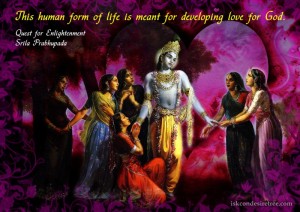Hare Krishna.
2nd Oct., 2015. Gurgaon.
“Sri Govindaji acts exactly like the siksa-guru. He is the original preceptor, for Govindaji gives us instructions and an opportunity to serve Him. The diksa-guru is a personal manifestation of the Sri Madana-mohana vigraha. Both of these Deities are worshiped at Vrindavana. Srila Gopinatha is the ultimate attraction of spiritual realization.” (CC Adi 1.47p.)
Sambandha

(Sri Radha Madan Mohan, Karauli)
Srila Sanatana Goswami is the acharya of sambandha, the process of understanding our relationship with Lord Krishna. The deity for Sambandha is Madan Mohan.
By receiving the mercy of the Radha-Madana-mohana Deity, and by studying the writings of the sambandha-acharya Srila Sanatana Gosvami, a devotee will attain sambandha-jnana, or knowledge of one’s spiritual identity and his eternal relationship with Sri Krishna. Srila Prabhupada states, “Madana-mohana, Sanatana Gosvami’s Deity, helps us progress in Krishna consciousness. In the execution of Krishna consciousness, our first business is to know Krishna and our relationship with Him, which we can learn by worshiping the Madana-mohana vigraha.”
Abhidheya

(Sri Radha Govind Devji, Jaipur)
Srila Rupa Goswami is the acahrya of abhidheya and he reveals how to execute devotional service. His Deity of Radha-Govindaji accepts service and gives inspiration for increasing surrender on the path of bhakti-yoga. By writing many books Srila Rupa Gosvami has very kindly established the scientific basis of bhakti. “Everyone should read this book, Nectar of Devotion, very attentively, because all the conclusive statements about the Kingdom of Bhakti are contained in this transcendentally valuable book. It is the essence of all Vedic scriptures enlightening about Krishna consciousness. If anyone reads this Nectar of Devotion very carefully, he will have all guidance in the Bhakti Cult.” (Srila Prabhupada lecture 6/27/70)
Prayojana

(Sri Radha Gopinatha, Jaipur)
Sri Raghunatha Dasa Goswami is our prayojana acharya. The Gopinatha Deity is Krishna as master and proprietor of the gopis, the totally surrendered devotees . The Gopinatha Deity represents the prayojana-tattva (truth about life’s ultimate goal”pure love of Krishna. Srila Raghunatha dasa Gosvami accepts the lotus feet of Srila Rupa Gosvami as his highest aspiration. He thus reveals the way to attain the perfection of one’s loving relationship with Sri Krishna. Through humble prayers and service to the Radha-Gopinatha Deity, and by imbibing the teachings and mercy of Srila Raghunatha dasa Gosvami, a devotee can quickly advance in devotional service and ultimately attain the goal of life, prema-bhakti. (MNS)
“The Gaudiya Vaisnavas who follow strictly in the line of Sri Caitanya Mahaprabhu worship the Divinity by chanting transcendental sounds meant to develop a sense of one’s transcendental relationship with the Supreme Lord (sambandha), and reciprocation of mellows of mutual affection (abhidheya), and ultimately, the achievement of the desired success in loving service (prayojana). These three Deities (Madana-mohana, Govindaji, Gopinatha) are worshiped in three different stages of one’s development. The followers of Sri Caitanya Mahaprabhu scrupulously follow these principles of approach.” (CC Adi 1.19p.)
In a seminar on bhakti culture HG Srimati Mataji shared three most beautiful verses to describe our relationship with Lord at above three stages, they are most practical for an aspiring devotee. We can recite these verses daily, also before our japa and even during the middle of our japa when the attentiveness seems to slip away. I am trying, and struggling, to follow the same but still reaping some benefits inspite of all my handicaps.
On Sambandha:
caitanyera dāsa muñi, caitanyera dāsa
caitanyera dāsa muñi, tāṅra dāsera dāsa
“I am a servant of Lord Caitanya, a servant of Lord Caitanya. I am a servant of Lord Caitanya, and a servant of His servants.” (cc Adi 6.86)
On Abhidheya:
daśa aparādha yena hṛdaye nā paśe
kṛpā kara mahāprabhu maji nāma rase
O Mahäprabhu, please be merciful to me so that the ten offenses never touch my heart, and I can always remain absorbed in the rasa of the Holy Name. (Harinäma Chintamani 13.59 Bhaktivinoda Thäkura)
On Prayojana:
“prema-dhana vinā vyartha daridra jīvana
‘dāsa’ kari’ vetana more deha prema-dhana”
“Without love of Godhead, My life is useless. Therefore I pray that You accept Me as Your servant and give Me the salary of ecstatic love of God.” (cc Antya 20.37)
As I write this blog, a verse which Krishnadāsa Kavirāja Gosvāmī, author of Caitanya-caritāmṛta, wrote, comes to my memory
vande caitanya-devaṁ taṁ bhagavantaṁ yad-icchayā
prasabhaṁ nartyate citraṁ lekha-raṅge jaḍo ’py ayam


